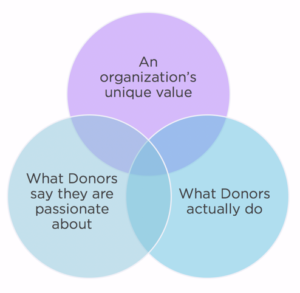It all starts with you. That may seem like a strange thing to say when we’re talking about building donor loyalty. But, when it comes to using data in your acquisition, focusing on your organization is honestly where you need to begin.
Before you can start meeting donors and developing relationships that flourish, you must first have a strong sense of who you are. You have to be able to sell yourself. If you had 30 seconds in an elevator with a donor, you should be able to talk about the unique value you offer in a quick, concise, and compelling way.
You have to understand what makes your organization unique and different from other organizations if you are going to be able to target and engage the right audience who will support you for the long haul.
When thinking about the unique value your nonprofit offers, where should you begin? To get a full, clear, honest, and accurate picture of your organization, start by spending some time with your leadership team and the people who know your organization the best: your current donors.
Find out…
- Why do your current loyal donors love and continue to support you?
- What do you do as an organization that no one else does?
- What would happen to your mission if you didn’t exist anymore?
Understanding Your “It” Factor
The answers to the questions above will help you determine what “it” is that makes your organization so unique and special. Once you identify “it”, you have an incredibly valuable piece of knowledge that you’ll want to capture and build into your marketing. You can then use “it” like a magnet to attract the people you’re looking for to your organization and your cause.
Using “It” to Find Your “Sweet Spot”
Once you know your unique value, you need to find the intersection between that unique value and what donors say they are passionate about, as well as what donors actually do. That intersection is your organization’s “sweet spot” for connecting with donors. Every organization has a “sweet spot”—and data can help you find it.

The two blue circles in the diagram above both represent sets of data.
The first one (“What Donors say they are passionate about”) is data captured directly from donors through things like survey research, monitoring social media, or gathered feedback. What people say is often the best way to get at motivations, why people are attracted to your organization, why they give to other organizations, etc.
However, what people say and what people do are often two different things.
That’s where the second circle (“What Donors actually do”) comes in. This circle contains behavioral data, showing actions from things like tracking RFM—how recently did they give, how much did they give, how often, etc. These are outcomes from the reasons individuals decided to do something. What they don’t reveal is the “why” behind those actions.
Taken by themselves, both of the blue circles of data don’t tell the whole story.
By joining them together, you’re able to fill in the gaps and get a clearer picture of the donor who is the most passionate and the most motivated to give. When you align that analysis with the purple circle—who you are as an organization—you can identify that “sweet spot” of your target audience and communicate your unique value proposition to the donors most motivated to engage.
Find out how you can combine strategy, analytics, and creative to acquire more loyal donors. Download our resource First Impressions of Acquisition now.

